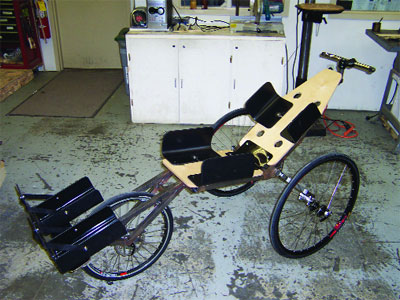New racing stroller paves the way for riders and runners

Students at the Hampshire College Lemelson Center (HCLC) in Amherst, MA, are committed to the design and fabrication of assistive devices (those that help people with physical, mental, and age-related disabilities) and of universal products (those to be used for the widest possible range of ability levels). In that vein, students Prateek Rajbhandari, Ismahil Olanrewaju, and Diana Pun designed and fabricated a prototype racing stroller that will meet the unique needs of riders who cannot sustain an upright seated position and of the runners who push them.
Within a 45-day period in 2006, Michael Wardian won four of the five major marathons he participated in. The following spring, he earned a position at the 2008 Olympic Trials after completing six marathons€”and winning three of them€”within seven weeks. But it is his performance at the 2007 Frederick (Maryland) Marathon for which he holds a Guinness World Record. The category: fastest runner to complete a marathon while pushing a jogging stroller. The occupant was Wardian's nine-month-old son.
In 1979, Dick Hoyt and son Rick began competing regularly as Team Hoyt after they completed a local 5-mile road race in which Dick ran while pushing Rick, who has cerebral palsy, in an upright wheelchair. Including their first Boston Marathon in 1981, the duo has participated in 66 marathons, 20 duathalons, and 229 triathalons. Last December, Team Hoyt added the Louisiana Independence Bowl's Spirit of Independence Award€ to a long list of honors.
Benefits of biomechanical innovation
Both the Wardian and Hoyt teams have benefited not only from the running capabilities of the fathers but also from the biomechanics-based innovation of those who developed the strollers occupied by their sons.
The same fervor that brought about the advent of community-based road races, such as the first one the Hoyts participated in, also spurred Phil Baechler's 1980 invention of the three-wheeled baby jogger. Baechler's original design has evolved into the now ubiquitous jogging stroller, which is optimal for the biomechanical needs of both the stroller's pusher and its occupant.
The Hoyts completed their first Boston Marathon in the top quarter of the field. Now they typically finish in the top 10%. This gain can be credited, in part, to advances in racing stroller technology.
Design specifications
The HCLC student project came about because an alumna was looking for an adult racing stroller to use while participating in marathons with her severely disabled sister. None of the commercially available models was suitable for her sister's needs. Not only would they require her to sit in an unsustainable position, but they also lacked suspension systems and tended to be too heavy to push for the length of a marathon.
The students' racing stroller is made with specially chosen lightweight materials. The frame is constructed from thin-walled, 1-inch-square chrome molybdenum tubing. The full-length seat pad is made from dual-density closed-cell foam and is covered by a breathable, water-resistant fabric. A hook-and-loop fastener attaches a small foam headrest to the seat pad.
The device's seating insert is composed of ABS plastic and high-grade plywood (1/2-inch Baltic birch). The insert permits the back angle to be adjusted, thus providing a position that allows the rider to recline. The insert's thigh and lateral supports also provide 4 inches of width adjustment.
A disk-based braking system can be hand-activated via a lever that sits on the stroller's ergonomic handlebars. The brake also acts as a tether-activated emergency brake. If the runner lets go of the racing stroller (for example, during a fall), the tether attached to the runner pulls a pin out of the emergency brake lever, causing it to activate the disk brake.
The design also features a rear-wheel swing-arm suspension system. All the wheels have quick releases to facilitate transporting the stroller to and from events.
The racing stroller design was developed with the help of both HCLC director Colin Twitchell and Niall Gengler, a recent alumnus and part-time center employee.
Market potential?
Although this was essentially a custom project, it's likely that there is a market for strollers of this type, Twitchell said. A segment of the disabled population is sensitive to excessive vibration, and the suspension system dramatically reduces the amount of road vibration transmitted to a person sitting in the stroller.
In addition, the innovative tether-based emergency brake could be incorporated into other strollers, including those made for the general consumer market.
Lynn M. Crevier holds degrees in ergonomics (with concentrations in biomechanics and neuroscience) and mechanical engineering. As a member of the University of Massachusetts Biomechanics Laboratory at the University of Massachusetts Amherst, she has helped conduct research on anterior cruciate ligament tears. This is the fourth installment in this new technology series.
